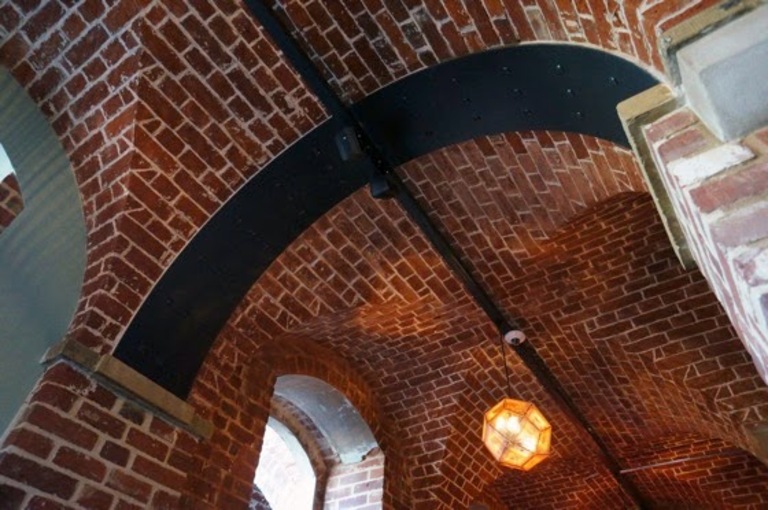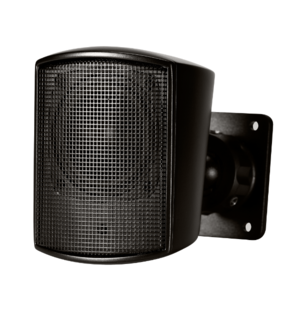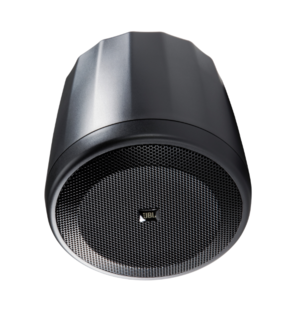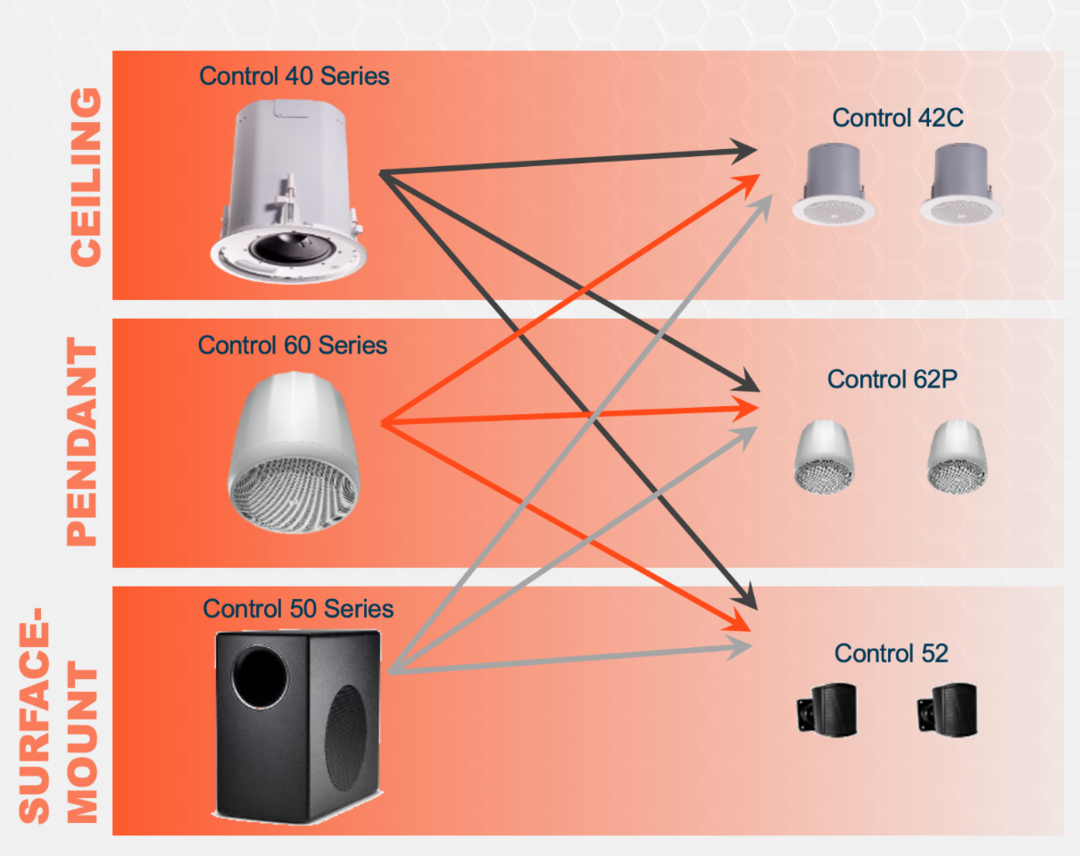
Before we get to accompanying subwoofers, let’s look at the small format speakers on their own. The in-ceiling Control 42P, the on-wall Control 52 and the pendant Control 62P all features the same JBL-designed 60mm (2.5 inch) driver. They offer high fidelity sound with very low distortion and consistent coverage pattern of 140 – 160 degrees conical. And because they are essentially the same loudspeaker in different physical formats, they can be mixed and matched within a system design at will.

JBL Control 42
In-Ceiling

JBL Control 52
Surface-Mount

JBL Control 62
Pendant
Used stand-alone they operate at 16 Ohms, and we recommend the signal should be high-passed at 140Hz to protect the drivers.
The Control 52 in particular has proven to be an extremely versatile and popular speaker for a variety of applications thanks to its ease of installation and small size. Think boardrooms, waiting areas, and even the choir pews of churches.
Whilst the audio frequency is naturally limited by the small size of the driver, all models deliver excellent sound quality, can deliver speech with extreme clarity, and do a surprisingly good job of background music playback.
Combining multiple small-format speakers with an accompanying subwoofer (known as a sub/sat system) is a brilliantly discrete way of providing full-range audio within a space. With the high—frequency speakers distributed around the space, and a sub-woofer providing low end this offers a well round sound suitable to many voice and BGM applications.
As with the small-format speakers, the matching JBL subwoofers also come as in-ceiling (Control 40CS/T), on-wall (Control 50S/T) or pendant (Control 60PS/T) format. All feature 150 Watt (600 Watt peak) power handling and low distortion, with the JBL long-excursion 8” LF driver delivering well-damped, tight sound quality, long-term reliability, good bass transient response, and excellent stability under high power, high duty-cycle, working conditions. The Control 50 in particular is a firm favourite with the applications team and offers versatility when designing distributed installed systems. We often pair it with other small format speakers such as the Control 23-1's or 25-1's to great success. The ability to use low or high impedance further increases their usefulness.

What makes the sub-sat systems from the JBL Control Contractor range stand out - besides their quality - is their versatility. There are three sub-sat systems in the Control Contractor range. These have been designed in such a way that they have similar sound character, frequency response, sensitivity, directivity, and impedance, meaning they can be used in combination with each other even within the same system – for instance combine Control 52 wall-mounted satellite speakers with a Control 40S/T subwoofer, or even two Control 42C and two Control 62P with a Control 50S/T.
The one condition is that each sub-sat system must contain at least two or four satellites but never one or three. This is because the crossover network built into the subwoofers contains two high-pass filters, each set to work properly with the impedance and sensitivity of two satellite speakers (16 ohms per speaker, divided by two gives 8 ohms).
Again the Control 50 Series sub/sat system, consisting of the Control 50 Subwoofer and Control 52 satellite speakers, has proved to be very popular. This system provides a very nice wide-bandwidth sound for places where you need excellent fidelity but may not need super-high SPL capability. It’s available as a “Pack,” or the individual speakers are available separately. And, of course, like the other subwoofer-satellite systems, the subwoofer or satellite can be intermixed with the corresponding in-ceiling or pendant models, depending on the needs of the architecture of the space.
All three of the systems can be run in low-impedance setting or on a 70V/100V line and this is easily changeable by using the tap setting switch on the sub. When running the system in low-Z the impedance is as follows:, the subwoofer by itself or with two satellites is 8 ohms, the subwoofer with four satellites is 4 ohms. When running a 70V/100V line to power the system the transformer in the sub can be set to 80W, 40W, 20W, plus 10W at 70V only. This relates to the power draw for just the sub or the sub with two satellites. For four satellites the power draw for the system increases by 30% (80W tap setting draws 104 Watts; the 40W tap setting draws 52 Watts; the 20W tap setting draws 26 Watts; and the 10W tap setting draws 13 Watts). If you have a larger space that requires more then one sub-sat system you can use two or more systems on same 70V/100V system given you have the correct power to drive multiple systems. You can also combine these systems with other systems on the same full-range 70V/100V line.
Finally, I would like to devote some time to discussing subwoofer placement as this is very important for achieving the right tonal balance in your installation. The location of a wall-mounted subwoofer in relation to the wall, floor or ceiling affects the tonal balance of the system. In systems having two satellite speakers, proper balance of sound is usually attained by installing the subwoofer via its wall-mount bracket at the centre of a wall (instead of mounting it at a 2-boundary area such as a wall-floor junction).
For systems with four satellite speakers mounting the subwoofer in the centre of a wall produces good basic bass levels. Locating the subwoofer at a two-boundary junction, such as a wall-floor or wall-wall junction, provides stronger bass. A corner location provides the strongest bass for maximum bass impact, although it may be too much bass, depending on the room. One of the things we love about the Control 50 sub is that it can be sat on the floor, mounted to the wall with the bracket or even mounted up above the roof margins or under/in furniture if aesthetics are a concern.
The ceiling and pendant subwoofer placement is different from the wall mounted as you will not place the sub directly on the wall barrier, but by placing it near the boundaries you can create a similar effect. Positioning the subwoofers within 3 feet of a wall increases its output by 3 dB (2 satellites). Placement within 3 feet of a corner increases its output yet another 3 dB (4 satellites) or 6 dB total, compared to being located away from a wall or ceiling. In these cases, there is both an increase in sensitivity (output per watt of input) and in maximum total SPL capability. External electronic equalisation such as tone controls or DSP can be utilised to adjust the tonal balance further.
Keep an eye out for our Install Subwoofer blog post which goes into more detail on boundary effect and the differences between floor and pendant speakers. We also have both setup in our Letchworth demo facility for demonstrating this.